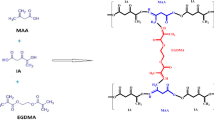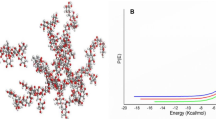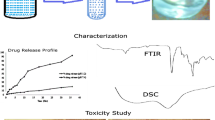Abstract
The present study was performed to evaluate the effect of chondroitin sulfate, acrylic acid and ammonium peroxodisulfate in formulation of a novel biodegradable and pH-sensitive hydrogel for targeted delivery of an anticancer drug oxaliplatin. The synthesized hydrogel was characterized by FTIR, thermal analysis and SEM. FTIR indicated efficient grafting. Thermogravimetric analysis depicted thermodynamically stable behavior. SEM of developed hydrogels revealed rough surface. pH-sensitivity was confirmed through swelling dynamics and drug release behavior at pH 1.2 and pH 7.4. Acute oral toxicity study indicated no mortality or any signs of acute toxicity during the whole observation period. Hence, the designed polymeric network could be considered safe and is potential candidate for colon targeting of oxaliplatin in colorectal cancer.











Similar content being viewed by others
References
Liu L, Fishman ML, Kost J, Hicks KB (2003) Pectin-based systems for colon-specific drug delivery via oral route. Biomater 24:3333–3343
Basit A, Bloor J (2003) Prespectives on colonic drug delivery, business briefing. Pharm Technol 185–190
Cheng G, An F, Zou MJ, Sun J, Hao XH, He YX (2004) Time-and pH-dependent colon-specific drug delivery for orally administered diclofenac sodium and 5-aminosalicylic acid. World J Gastroenterol 10:1769
Vemula SK, Veerareddy PR (2009) Different approaches to design and evaluation of colon specific drug delivery systems. Int J Pharm Tech 1:1–35
Orlu M, Cevher E, Araman A (2006) Design and evaluation of colon specific drug delivery system containing flurbiprofen microsponges. Int J Pharm 318:103–117
Ferlay J (2001) GLOBOCAN 2000. Cancer incidence, mortality and prevalence worldwide, version 1.0. IARC cancerbase
Obrand DI, Gordon PH (1997) Incidence and patterns of recurrence following curative resection for colorectal carcinoma. Dis Colon Rectum 40:15–24
Pucciarelli S, Friso ML, Toppan P, Fornasiero A, Carnio S, Marchiori E, Lise M (2000) Preoperative combined radiotherapy and chemotherapy for middle and lower rectal cancer: preliminary results. Ann Surg Oncol 7:38–44
Raymond E, Chaney S, Taamma A, Cvitkovic E (1998) Oxaliplatin: a review of preclinical and clinical studies. Ann Oncol 9:1053–1071
Luo FR, Wyrick SD, Chaney SG (1998) Cytotoxicity, cellular uptake, and cellular biotransformations of oxaliplatin in human colon carcinoma cells. Oncol Res Featur Preclin Clin Cancer Ther 10:595–603
Han B, Xu R, Shi Y, Luo H, Xiang X, Li Y et al (2007) Oxaliplatin, fluorouracil and leucovorin (FOLFOX) as first-line chemotherapy for metastatic or recurrent colorectal cancer patients. Chin J Clin Oncol 4:397–400
Wichterle O, Lim D (1960) Hydrophilic gels for biological use. Nature 185:117–118
Hoffman AS (2012) Hydrogels for biomedical applications. Adv Drug Deliv Rev 64:18–23
Hamidi M, Azadi A, Rafiei P (2008) Hydrogel nanoparticles in drug delivery. Adv Drug Deliv Rev 60:1638–1649
Peppas NA, Hilt JZ, Khademhosseini A, Langer R (2006) Hydrogels in biology and medicine: from molecular principles to bionanotechnology. Adv Mater 18:1345–1360
Qiu Y, Park K (2001) Environment-sensitive hydrogels for drug delivery. Adv Drug Deliv Rev 53:321–339
Rajpurohit H, Sharma P, Sharma S, Bhandari A (2010) Polymers for colon targeted drug delivery. Indian J Pharm Sci 72:689
Amin MC, Ahmad N, Halib N, Ahmad I (2012) Synthesis and characterization of thermo-and pH-responsive bacterial cellulose/acrylic acid hydrogels for drug delivery. Carbohydr Polym 88:465–473
Pooley SA, Rivas BL, Lillo FE, Pizarro GD (2010) Hydrogels from acrylic acid with N, N-dimethylacrylamide: synthesis, characterization, and water absorption properties. J Chil Chem Soc 55:19–24
Koetting MC, Peppas NA (2014) pH-Responsive poly (itaconic acid-co-N-vinylpyrrolidone) hydrogels with reduced ionic strength loading solutions offer improved oral delivery potential for high isoelectric point-exhibiting therapeutic proteins. Int J Pharm 471:83–91
Samantha HS, Ray SK (2014) Synthesis, characterization, swelling and drug release behavior of semi-interpenetrating network hydrogels of sodium alginate and polyacrylamide. Carbohydr Polym 99:666–678
Khalid I, Ahmad M, Usman Minhas M, Barkat K, Sohail M (2018) Cross-linked sodium alginate-g-poly (acrylic acid) structure: a potential hydrogel network for controlled delivery of loxoprofen sodium. Adv Polym Technol 37:985–995
Khalid I, Ahmad M, Minhas MU, Sohail M (2014) Formulation and in vitro evaluation of mucoadhesive controlled release matrix tablets of flurbiprofen using response surface methodology. Braz J Pharm Sci 50:493–504
Najib N, Suleiman M (1985) The kinetics of drug release from ethylcellulose solid dispersions. Drug Dev Ind Pharm 11:2169–2181
Desai S, Simonelli A, Higuchi W (1965) Investigation of factors influencing release of solid drug dispersed in inert matrices. J Pharm Sci 54:1459–1464
Higuchi T (1963) Mechanism of sustained action medication. Theoretical analysis of rate of release of solid drugs dispersed in solid matrices. J Pharm Sci 52:1145–1149
Peppas N (1985) Analysis of Fickian and non-Fickian drug release from polymers. Pharm Acta Helv 60:110–111
Crispim E, Piai J, Fajardo A, Ramos E, Nakamura T, Nakamura C, Rubira A, Muniz E (2012) Hydrogels based on chemically modified poly (vinyl alcohol) (PVA-GMA) and PVA-GMA/chondroitin sulfate: preparation and characterization. Express Polym Lett 6:383–395
Wang L, Wang Z, Zhang X, Shen J, Chi L, Fuchs H (1997) A new approach for the fabrication of an alternating multilayer film of poly (4-vinylpyridine) and poly (acrylic acid) based on hydrogen bonding. Macromol Rapid Commun 18:509–514
Tarducci C, Schofield W, Badyal J, Brewer S, Willis C (2002) Synthesis of cross-linked ethylene glycol dimethacrylate and cyclic methacrylic anhydride polymer structures by pulsed plasma deposition. Macromolecules 35:8724–8727
He H, Xiao H, Kuang H, Xie Z, Chen X, Jing X, Huang Y (2014) Synthesis of mesoporous silica nanoparticle–oxaliplatin conjugates for improved anticancer drug delivery. Colloids Surf B 117:75–81
Hu Y, Jiang X, Ding Y, Ge H, Yuan Y, Yang C (2002) Synthesis and characterization of chitosan–poly (acrylic acid) nanoparticles. Biomater 23:3193–3201
Fajardo AR, Silva MB, Lopes LC, Piai JF, Rubira AF, Muniz EC (2012) Hydrogel based on an alginate–Ca2+/chondroitin sulfate matrix as a potential colon-specific drug delivery system. RSC Adv 2:11095–11103
Ali L, Ahmad M, Usman M, Yousuf M (2014) Controlled release of highly water-soluble antidepressant from hybrid copolymer poly vinyl alcohol hydrogels. Polym Bull 71:31–46
Amrutkar JR, Gattani SG (2009) Chitosan–chondroitin sulfate-based matrix tablets for colon specific delivery of indomethacin. AAPS PharmSciTech 10:670–677
Lee C-T, Huang C-P, Lee Y-D (2007) Synthesis and characterizations of amphiphilic poly (l-lactide)-grafted chondroitin sulfate copolymer and its application as drug carrier. Biomol Eng 24:131–139
Mandal B, Ray SK (2013) Synthesis of interpenetrating network hydrogel from poly (acrylic acid-co-hydroxyethyl methacrylate) and sodium alginate: modeling and kinetics study for removal of synthetic dyes from water. Carbohydr Polym 98:257–269
Lee C-T, Kung P-H, Lee Y-D (2005) Preparation of poly (vinyl alcohol)-chondroitin sulfate hydrogel as matrices in tissue engineering. Carbohydr Polym 61:348–354
Ranjha NM, Ayub G, Naseem S, Ansari MT (2010) Preparation and characterization of hybrid pH-sensitive hydrogels of chitosan-co-acrylic acid for controlled release of verapamil. J Mater Sci Mater Med 21:2805–2816
Ramelow US, Pingili S (2010) Synthesis of ethylene glycol dimethacrylate-methyl methacrylate copolymers, determination of their reactivity ratios, and a study of dopant and temperature effects on their conductivities. Polymers 2:265–285
Hussain T, Ranjha NM, Shahzad Y (2011) Swelling and controlled release of tramadol hydrochloride from a pH-sensitive hydrogel. Des Monomers Polym 14:233–249
Huang L, Sui W, Wang Y, Jiao Q (2010) Preparation of chitosan/chondroitin sulfate complex microcapsules and application in controlled release of 5-fluorouracil. Carbohydr Polym 80:168–173
Zarzycki R, Modrzejewska Z, Nawrotek K (2010) Drug release from hydrogel matrices. Ecol Chem Eng S 17:117–136
Jaykaran BP, Kantharia N, Yadav P, Panwar A (2009) Acute toxicity study of an aqueous extract of Ficus racemosa Linn. bark in albino mice. Internet J Toxicol 6(1):1–6
Arvind P, Nilesh C, Manoj S, Preeti Y (2010) Subacute toxicity study of an aqueous extract of Ficus racemosa Linn. bark in rats. J Pharm Res 3:814–817
Erum A, Bashir S, Saghir S, Tulain UR, Saleem U, Nasir M, Kanwal F, Hayat Malik MN (2015) Acute toxicity studies of a novel excipient arabinoxylan isolated from Ispaghula (Plantago ovata) husk. Drug Chem Toxicol 38:300–305
Pariyani R, Safinar Ismail I, Azam AA, Abas F, Shaari K, Sulaiman MR (2015) Phytochemical screening and acute oral toxicity study of Java tea leaf extracts. BioMed Res Int 2015:1–8
Sreejayan N, Marone PA, Lau FC, Yasmin T, Bagchi M, Bagchi D (2010) Safety and toxicological evaluation of a novel chromium(III) dinicocysteinate complex. Toxicol Mech Methods 20:321–333
Author information
Authors and Affiliations
Corresponding author
Ethics declarations
Conflict of interest
The author reports no conflict of interest.
Human and animal rights
All institutional and national guidelines for the care and use of laboratory animals were followed.
Additional information
Publisher's Note
Springer Nature remains neutral with regard to jurisdictional claims in published maps and institutional affiliations.
Rights and permissions
About this article
Cite this article
Barkat, K., Ahmad, M., Minhas, M.U. et al. Chondroitin sulfate-based smart hydrogels for targeted delivery of oxaliplatin in colorectal cancer: preparation, characterization and toxicity evaluation. Polym. Bull. 77, 6271–6297 (2020). https://doi.org/10.1007/s00289-019-03062-w
Received:
Revised:
Accepted:
Published:
Issue Date:
DOI: https://doi.org/10.1007/s00289-019-03062-w




